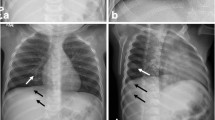Abstract
Skeletal injuries are commonly encountered in infants and young children with abusive head trauma. Although certain patterns of intracranial injury suggest abuse, none are diagnostic. Therefore demonstration of associated unsuspected skeletal injuries has important implications, particularly when highly specific fractures are present. Skull fractures are commonly associated with intracranial injury, but no fracture pattern is indicative of physical abuse. Other skeletal injuries including classic metaphyseal lesions and rib, spine and scapular fractures are strong predictors of abusive head trauma in infants with intracranial injury. It is mandatory to perform rigorous skeletal surveys in infants and young children with clinical and neuroimaging findings concerning for abusive head trauma.




Similar content being viewed by others
References
Caffey J (1946) Multiple fractures in the long bones of infants suffering from chronic subdural hematoma. Am J Roentgenol Radium Ther 56:163–173
Kempe CH, Silverman FN, Steele BF et al (1962) The battered-child syndrome. JAMA 181:17–24
Piteau SJ, Ward MGK, Barrowman NJ et al (2012) Clinical and radiographic characteristics associated with abusive and nonabusive head trauma: a systematic review. Pediatrics 130:315–323
Maguire SA, Kemp AM, Lumb RC et al (2011) Estimating the probability of abusive head trauma: a pooled analysis. Pediatrics 128:e550–564
Duffy SO, Squires J, Fromkin JB et al (2011) Use of skeletal surveys to evaluate for physical abuse: analysis of 703 consecutive skeletal surveys. Pediatrics 127:e47–52
Reece RM, Sege R (2000) Childhood head injuries: accidental or inflicted? Arch Pediatr Adolesc Med 154:11–15
Kleinman P (1998) Diagnostic imaging of child abuse, 2nd edn. Mosby, Maryland Heights
Kemp AM, Dunstan F, Harrison S et al (2008) Patterns of skeletal fractures in child abuse: systematic review. Br Med J 337:a1518
Merten DF, Osborne DR, Radkowski MA et al (1984) Craniocerebral trauma in the child abuse syndrome: radiological observations. Pediatr Radiol 14:272–277
Hobbs CJ (1984) Skull fracture and the diagnosis of abuse. Arch Dis Child 59:246–252
Meservy CJ, Towbin R, McLaurin RL et al (1987) Radiographic characteristics of skull fractures resulting from child abuse. AJR Am J Roentgenol 149:173–175
Barber I, Perez-Rossello JM, Wilson CR et al (2014) The yield of high-detail radiographic skeletal surveys in suspected infant abuse. Pediatr Radiol. doi:10.1007/s0024701430643
Wood JN, Christian CW, Adams CM et al (2009) Skeletal surveys in infants with isolated skull fractures. Pediatrics 123:e247–e252
Laskey AL, Stump TE, Hicks RA et al (2013) Yield of skeletal surveys in children ≤18 months of age presenting with isolated skull fractures. J Pediatr 162:86–89
Deye KP, Berger RP, Lindberg DM et al (2013) Occult abusive injuries in infants with apparently isolated skull fractures. J Trauma Acute Care Surg 74:1553–1558
Day F, Clegg S, McPhillips M et al (2006) A retrospective case series of skeletal surveys in children with suspected non-accidental injury. J Clin Forensic Med 13:55–59
Karmazyn B, Lewis ME, Jennings SG et al (2011) The prevalence of uncommon fractures on skeletal surveys performed to evaluate for suspected abuse in 930 children: should practice guidelines change? AJR Am J Roentgenol 197:W159–W163
King J, Diefendorf D, Apthorp J et al (1988) Analysis of 429 fractures in 189 battered children. J Pediatr Orthop 8:585–589
Kleinman PK, Perez-Rossello JM, Newton AW et al (2011) Prevalence of the classic metaphyseal lesion in infants at low versus high risk for abuse. AJR Am J Roentgenol 197:1005–1008
Tsai A, McDonald AG, Rosenberg AE et al (2014) High-resolution CT with histopathological correlates of the classic metaphyseal lesion of infant abuse. Pediatr Radiol 44:124–140
Swischuk LE (1969) Spine and spinal cord trauma in the battered child syndrome. Radiology 92:733–738
Kemp AM, Joshi AH, Mann M et al (2010) What are the clinical and radiological characteristics of spinal injuries from physical abuse: a systematic review. Arch Dis Child 95:355–360
Barber I, Perez-Rossello JM, Wilson CR et al (2013) Prevalence and relevance of pediatric spinal fractures in suspected child abuse. Pediatr Radiol 43:1507–1515
American College of Radiology (2011) ACR–SPR practice guideline for skeletal surveys in children: revised 2011 (resolution 54). ACR, Reston, VA, pp 1–6. http://www.acr.org/~/media/9bdcdbee99b84e87baac2b1695bc07b6.pdf. Accessed 29 May 2014
Drubach LA, Johnston PR, Newton AW et al (2010) Skeletal trauma in child abuse: detection with 18 F-NaF PET. Radiology 255:173–181
Perez-Rossello JM, Connolly SA, Newton AW et al (2010) Whole-body MRI in suspected infant abuse. AJR Am J Roentgenol 195:744–750
Conflicts of interest
None
Author information
Authors and Affiliations
Corresponding author
Rights and permissions
About this article
Cite this article
Barber, I., Kleinman, P.K. Imaging of skeletal injuries associated with abusive head trauma. Pediatr Radiol 44 (Suppl 4), 613–620 (2014). https://doi.org/10.1007/s00247-014-3099-5
Received:
Accepted:
Published:
Issue Date:
DOI: https://doi.org/10.1007/s00247-014-3099-5




